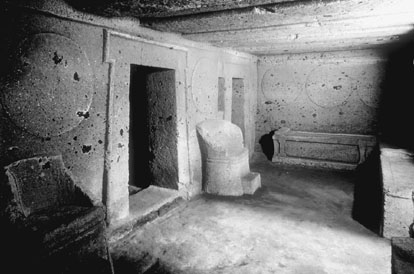

 | Page 474 |  |
The British appetite for the Etruscans was whetted in these years by the opening of a show of Etruscan tombs in London (1836–1837) by the Campanari family, which had excavated extensively at Tuscania. A spate of publications in English on the Etruscans followed (Haynes 2000). First was Elisabeth Hamilton Gray’s popular account, Tour of the Sepulchres of Etruria in 1839, a record of a visit to Italy that had been directly inspired by the Campanari show. Next Byres’s Hypogaei (1842) appeared, but most significant of all was the work by George Dennis, an English government official who relieved the boredom of his assignments by travel and study in Italy and other countries.

Entrance to the tomb of the Necropolis at Cerveteri
(Ann Ronan Picture Library)
Dennis’s masterpiece, The Cities and Cemeteries of Etruria, appeared in three printings (1848; rev. eds., 1878 and 1883) and preserves an exceptionally good record of the sites of Etruria as they appeared in the 1840s when he visited them. Dennis described the topography of each locality, including the monuments and the important finds up to that time as well as relevant literary evidence. The book included illustrations by Dennis himself as well as a few by his traveling companion, the painter Samuel James Ainsley, whose many drawings, now in the british museum, also record the condition of Etruria in the 1840s.
The collecting of Etruscan antiquities and the formation of museum displays became increasingly important. In 1838, the British Museum purchased much of the material from the Campanari show, and the Museo Gregoriano displayed Etruscan antiquities excavated by Vincenzo Campanari at Vulci in the 1830s (Buranelli 1992). The most sensational event in the distribution of Etruscan objects occurred with the sale of the vast collections of Marchese Campana beginning in 1858 (Les étrusques et l’Europe 1992, 350–361). After investigations revealed that Campana had embezzled funds from a bank he directed in Rome to sustain his collecting activities, officials seized his holdings. The material was sold off in lots to the British Museum, the Capitoline Museum in Rome, the Russian imperial collections at the Hermitage in St. Petersburg, and above all, the louvre in Paris. Of the antiquities that went to Paris, of special interest were the painted archaic Campana plaques from
 |  |